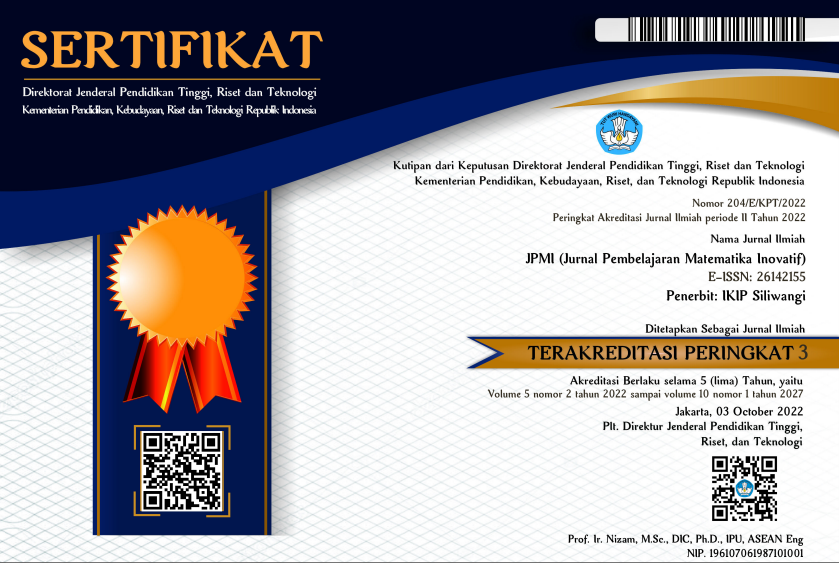Proses berpikir kreatif siswa dalam menyelesaikan soal kontekstual pada materi perbandingan berdasarkan teori Wallas
DOI:
https://doi.org/10.22460/jpmi.v7i4.20349Kata Kunci:
Creative Thingking Process, Contextual Problems, Comparative Material, Wallas theoryAbstrak
This study aims to determine and describe the creative thinking process skills of SMP Negeri 2 Sungai Ambawang students in solving contextual problems related to the topic of ratios based on Wallas' theory. The research method used is descriptive method with a qualitative approach. The research instruments used were creative thinking tests and interview guidelines. The data sources used were the answers to students' creative thinking tests and the results of interviews with students by researchers. This study reveals about students' creative thinking processes with three criteria for thinking levels, namely students with high, medium and low abilities. Of the 22 students, 23% were at a high creative thinking level, 32% were at a moderate creative thinking level and 45% were at a low creative thinking level. Students who are at a high level of creative thinking are able to go through all stages of creative thinking based on Wallas, at an intermediate level they are able to go through the Wallas creative thinking stage but are constrained in verification and do not find more than one way of solving it, while students at a low level do not go through the preparation stage and verification but find creative ways to solve problems.
Referensi
Amalia, E., Surya, E., & Syahputra, E. (2017). The effectiveness of using problem-based learning (pbl) in mathematics problem solving ability for junior high school students view project mathematic education view project the effectiveness of using problem based learning (pbl) in mathematics problem so. Ijariie, 3(2), 2017. https://www.researchgate.net/publication/318982082
Ariantika, Y. (2018). Pengaruh penggunaan pendekatan kontekstual berbantuan media realia terhadap hasil belajar matematika pada peserta didik kelas IV SDN 1 HARAPAN JAYA BANDAR LAMPUNG. BMC Microbiology, 17(1).
Febriani, S., & Ratu, N. (2018). Profil proses berpikir kreatif matematis siswa dalam pemecahan masalah open-ended berdasarkan teori wallas. Mosharafa: Jurnal Pendidikan Matematika, 7(1). https://doi.org/10.31980/mosharafa.v7i1.340
Isvina, W. Y., Sugiarti, T., & Kurniati, D. (2015). Proses berpikir kreatif dalam memecahkan masalah sub pokok bahasan trapesium berdasarkan tahapan wallas ditinjau dari adversity quotient ( AQ ) Siswa Kelas VII-C SMP Negeri 1 Jember. Artikel Ilmiah Mahasiswa, 1(1).
Jailani, Sugiman, Retnawati, H., Bukhori, Apino, E., Djidu, H., & Arifin, Z. (2018). Desain pembelajaran matematika untuk melatihkan higher order thinking skills. In UNY Press (Issue January).
Jazim, J., Anwar, R. B., & Rahmawati, D. (2017). Pengembangan modul matematika smp berbasis pendekatan konstruktivisme. AKSIOMA Journal of Mathematics Education, 5(2). https://doi.org/10.24127/ajpm.v5i2.667
Maharani, H. R., Sukestiyarno, S., & Waluya, B. (2017). Creative thinking process based on wallas model in solving mathematics problem. International Journal on Emerging Mathematics Education, 1(2). https://doi.org/10.12928/ijeme.v1i2.5783
Megawati, E. L. (2018). Pengembangan masalah kontekstual dengan memanfaatkan berita lintas media untuk mendukung pembelajaran matematika dengan pendekatan konstruktivisme. Universitas Sanata Dharma.
Melanie, M. E., Hartoyo, A., & Ahmad, D. (2019). Deskripsi proses penyelesaian soal cerita materi perbandingan pada siswa kelas VII SMP. Journal of Chemical Information and Modeling, 53(9).
Nuha, M. A., Waluya, S. B., & Junaedi, I. (2018). Mathematical creative process wallas model in students problem posing with lesson study approach. International Journal of Instruction, 11(2). https://doi.org/10.12973/iji.2018.11236a
Nurwahyuni, Sugiatno, & Ahmad, D. (2020). Potensi berpikir kreatif peserta didik dalam pemecahan masalah matematis berdasarkan teori wallas di SMP. Jurnal Pendidikan Dan Pembelajaran Khatulistiwa, 9(7), 1–12. https://jurnal.untan.ac.id/index.php/jpdpb/article/view/41152
Purwaningrum, J. P. (2016). Pengembangan kemampuan berpikir kreatif matematis melalui discovery learning. Pasundan Journal of Mathematics Education : Jurnal Pendidikan Matematika, Vol 6 No. 2. https://doi.org/10.23969/pjme.v6i2.2657
Puspitasari, L., In’am, A., & Syaifuddin, M. (2018). Analysis of students’ creative thinking in solving arithmetic problems. International Electronic Journal of Mathematics Education, 14(1). https://doi.org/10.12973/iejme/3962
Rohmawati, A. . (2015). Proses kreativitas siswa kelas XI dalam menyelesaikan soal matematika pada materi fungsi di MAN Tlogo Blitar Tahun Ajaran 2014/2015. Institut Agama Islam Negeri (IAIN), Tulungagung.
Sari, A. P., Ikhsan, M., & Saminan, S. (2017). Proses berpikir kreatif siswa dalam memecahkan masalah matematika berdasarkan model wallas. Beta Jurnal Tadris Matematika, 10(1). https://doi.org/10.20414/betajtm.v10i1.102
Sari, N. M. (2020). Analisis kesulitan siswa dalam mengerjakan soal matematika materi perbandingan kelas VII SMP Luhur Baladika. Jurnal Equation: Teori Dan Penelitian Pendidikan Matematika, 3(1).
Savira, F., & Suharsono, Y. (2013). Self-regulated learning (SRL) dengan prokrastnasi akademik pada siswa akselerasi. jurnal ilmiah psikologi terapan, 01(01).
Sugiyono. (2015). Sugiyono, Metode penelitian dan pengembangan pendekatan kualitatif, kuantitatif, dan R&D , (Bandung: Alfabeta, 2015), 407 1. Metode Penelitian Dan Pengembangan Pendekatan Kualitatif, Kuantitatif, Dan R&D, 2015.
Ulinnuha, R., Budi Waluya, S., Rochmad, R., NoKm, P., & Kedu, K. (2021). Creative thinking ability with open-ended problems based on self-efficacy in gnomio blended learning. Unnes Journal of Mathematics Education Research, 10(1), 20–25. http://journal.unnes.ac.id/sju/index.php/ujmer
Utami, M. (2012). Pengembangan kreativitas anak berbakat / Utami Munandar. In Psykologi Anak. Rineka Cipta.
Wasahua, S. (2021). Konsep pengembangan berpikir kritis dan berpikir kreatif peserta didik di sekolah dasar. Horizon Pendidikan, 16(2)
Unduhan
Diterbitkan
Terbitan
Bagian
Lisensi

Artikel ini berlisensiCreative Commons Attribution-ShareAlike 4.0 International License.
The author is responsible for acquiring the permission(s) to reproduce any copyrighted figures, tables, data, or text that are being used in the submitted paper. Authors should note that text quotations of more than 250 words from a published or copyrighted work will require grant of permission from the original publisher to reprint. The written permission letter(s) must be submitted together with the manuscript.
















